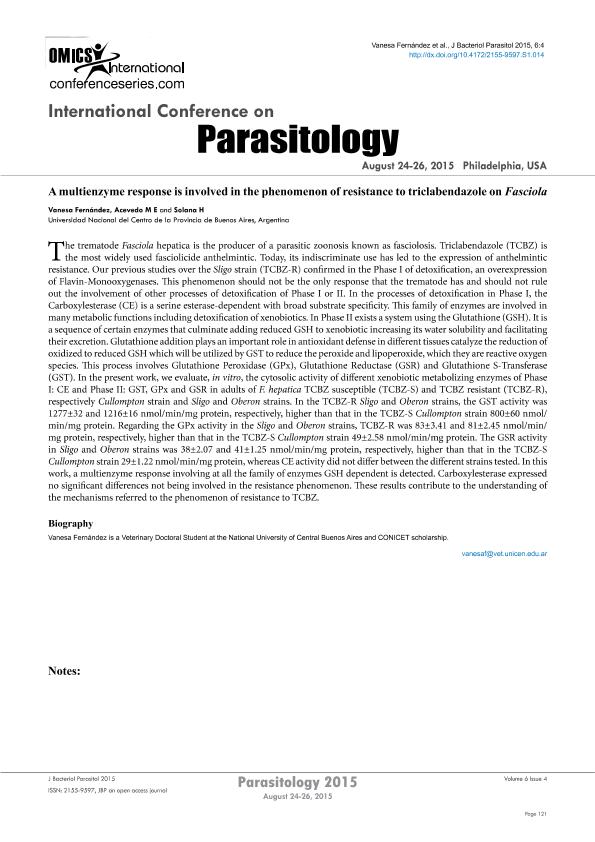Evento
A multienzyme response is involved in the phenomenon of resistance to triclabendazole on Fasciola
Tipo del evento:
Conferencia
Nombre del evento:
International Conference on Parasitology
Fecha del evento:
24/08/2015
Institución Organizadora:
OMICS Publishing Group;
Título de la revista:
Journal of Bacteriology & Parasitology
Editorial:
Walsh Medical Media
ISSN:
2155-9597
Idioma:
Inglés
Clasificación temática:
Resumen
The trematode Fasciola hepatica is the producer of a parasitic zoonosis known as fasciolosis. Triclabendazole (TCBZ) is the most widely used fasciolicide anthelmintic. Today, its indiscriminate use has led to the expression of anthelmintic resistance. Our previous studies over the Sligo strain (TCBZ-R) confirmed in the Phase I of detoxification, an overexpression of Flavin-Monooxygenases. This phenomenon should not be the only response that the trematode has and should not rule out the involvement of other processes of detoxification of Phase I or II. In the processes of detoxification in Phase I, the Carboxylesterase (CE) is a serine esterase-dependent with broad substrate specificity. This family of enzymes are involved in many metabolic functions including detoxification of xenobiotics. In Phase II exists a system using the Glutathione (GSH). It is a sequence of certain enzymes that culminate adding reduced GSH to xenobiotic increasing its water solubility and facilitatingtheir excretion. Glutathione addition plays an important role in antioxidant defense in different tissues catalyze the reduction of oxidized to reduced GSH which will be utilized by GST to reduce the peroxide and lipoperoxide, which they are reactive oxygen species. This process involves Glutathione Peroxidase (GPx), Glutathione Reductase (GSR) and Glutathione S-Transferase (GST). In the present work, we evaluate, in vitro, the cytosolic activity of different xenobiotic metabolizing enzymes of Phase I: CE and Phase II: GST, GPx and GSR in adults of F. hepatica TCBZ susceptible (TCBZ-S) and TCBZ resistant (TCBZ-R),respectively Cullompton strain and Sligo and Oberon strains. In the TCBZ-R Sligo and Oberon strains, the GST activity was 1277±32 and 1216±16 nmol/min/mg protein, respectively, higher than that in the TCBZ-S Cullompton strain 800±60 nmol/ min/mg protein. Regarding the GPx activity in the Sligo and Oberon strains, TCBZ-R was 83±3.41 and 81±2.45 nmol/min/ mg protein, respectively, higher than that in the TCBZ-S Cullompton strain 49±2.58 nmol/min/mg protein. The GSR activity in Sligo and Oberon strains was 38±2.07 and 41±1.25 nmol/min/mg protein, respectively, higher than that in the TCBZ-S Cullompton strain 29±1.22 nmol/min/mg protein, whereas CE activity did not differ between the different strains tested. In this work, a multienzyme response involving at all the family of enzymes GSH dependent is detected. Carboxylesterase expressed no significant differences not being involved in the resistance phenomenon. These results contribute to the understanding of the mechanisms referred to the phenomenon of resistance to TCBZ.
Palabras clave:
MULTIENZYMATIC RESPONSE
,
FASCIOLA
,
TCBZ
Archivos asociados
Licencia
Identificadores
Colecciones
Eventos(CIVETAN)
Eventos de CENTRO DE INVESTIGACION VETERINARIA DE TANDIL
Eventos de CENTRO DE INVESTIGACION VETERINARIA DE TANDIL
Citación
A multienzyme response is involved in the phenomenon of resistance to triclabendazole on Fasciola; International Conference on Parasitology; Philadelphia; Estados Unidos; 2015; 121-121
Compartir




